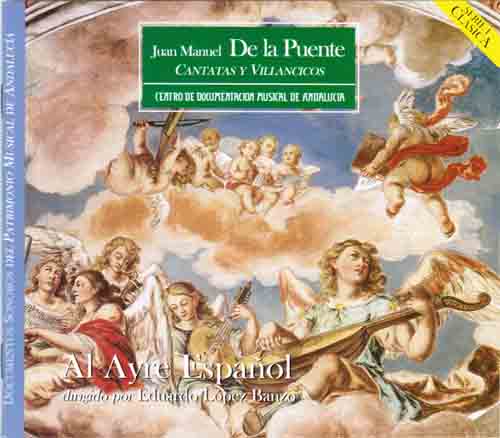Juan Manuel de la Puente
Detail DS - 0102 You can buy this record here 11 € Juan Manuel de la Puente Cantatas y Villancicos
Juan Manuel De la Puente (1692-1753) CANTATAS Y VILLANCICOS
Cantata a cuatro con Violines y Baxo a la Assumpzion, "Quién es esta aurora" (1730) 1. Yntroduccion 1'27" 2. Recitado 0'42" 3. Aria 3'36" 4. Recitado 0'51" 5. Minué-Grabe 3'36"
Villancico a cuatro con Violines al Nacimiento, "Niño Tierno" (1732) 6. Estribillo-Coplas 4'11"
Cantata a dúo con Violines al Santisaimo Sto., "La llama más divina" 7. Aria-Grabe 1'49" 8. Recitado 0'41" 9. Aria 3'41" 10. Recitado 0'32" 11. Minué-Grabe 3'05"
Cantata a cuatro con Violines al Nto. Sr. Xto., "Nunca con más sosiego" (1724) 12. Yntroduccion 1'28" 13. Recitado 0'45" 14. Aria 1'23" 15. Recitado 0'38" 16. Aria 2'32" 17. Arrastre-Grabe 0'35"
Cantata con Violines al Santísimo, "Etéreos Paraninfos" (1724) 18. Yntroduccion 2'39" 19. Recitado 0'48" 20. Coplas 2'53" 21. Recitado 0'38" 22. Aria-Grabe 4'03"
Villancico a tres a la Santísima Trinidad "Que dichoso captiberio" (1725) 23. Yntroduccion 2'24" 24. Recitado 0'53" 25. Aria 1'22" 26. Recitado 0'52" 27. Arieta-Grabe 1'39"
Cantata a cuatro con Violines i basso al Sr. S. Pedro "O Principe Soberano" 28. Yntroduccion 1'03" 29. Recitado 0'46" 30. Aria 2'53" 31. Recitado 0'56" 32. Arieta-Grabe 2'27"
Duración TOTAL 58'08"
|
About JUAN MANUEL DE LA PUENTE (1692-1753) CANTATAS Y VILLANCICOS
Two factors point to Juan Manuel de la Puente as one of the great choirmasters of Jaén Cathedral: his extensive musical work, largely preserved in the Cathedral itself and the interest shown him by musicologists such as Robert Stevenson who said of him "...a credit to the church of Jaén, may his memory live on to be elevated to the place of preference it deserves..." De la Puente was born in Tomelloso (Guadalajara) in 1692 and died in Jaén itself, in 1753. His early years were spent at his birthplace though he later received his first musical instruction as a chorister at Toledo Cathedral. At that time, his teachers and influences would have been Pedro de Ardanaz, Juan de Bonet and Miguel de Ambiela, who were his choirmasters up till the age of nineteen when he moved on to take charge in Jaén after passing the obligatory rigorous tests. There were, in fact, seven other candidates for the position. Agustín de Contreras, choirmaster at Córdoba Cathedral, presided over the panel of examiners. In 1716, after the necessary investigations had been carried out to verify purity of lineage, he was named "maestro de capilla" at the chapel then under his auspices. From that time on, he was to dedícate his life to the musical direction of the Cathedral, fulfilling the obligations of the teaching of music, supervision of musical activities in the chapel and compositions for the different religious festivals. Later, in 1732, and possibly due to friction between himself and the Chapter at Jaén Cathedral, he made known his aspirations to become choirmaster at Málaga Cathedral. However, as far as can be determined, he remained at Jaén for the rest of his lifetime, without travelling any great distance. This is evident through his own writings of 1751: "over forty years of rendering service in continued residence". That same year he fell seriously ill and asked to be relieved of his "Villancico" composition duties. However, a year later, as joint Principal of the Colegio del Santísimo Sacramento (College of the Most Holy Sacrament), he was obliged by circumstances to visit the spa tocan of Ardales (Málaga), seeking relief from his continued affliction. His efforts proved to be in vain and by the following year, he had passed on. He left behind, at Jaén Cathedral, an important legacy of over 50 latin pieces of written musical score, apart from other works in castellano (among these, about a hundred "villancicos"). This bequestwas further enriched in 1786 at the death of Francisco de Viedma, transcriber of part of De la Puente's work and choirmaster at Alcaudete, by 9 books of music as we11 as a series of various "Villancicos y Misas" (unspecified). Of these 9 bound parchment volumes, only three Nave survived and only one of the aforementioned 50 pieces in latin is intact. In all, 284 works remain of which 154 are cantatas and villancicos. Most of the Cantatas were written for solo voice and consist mairily of religious advocations dedicated to the Holy Sacrament. They would have been performed principa ly around the day of Corpus Christi.The Cantata, with its typical alternation of Recitado and Aria, often preceded by an Introducción and ending with a Grave, a format which gives them the religious character intended, appears in the work of the maestro as distinct from the Villancico (origin of the Cantata) with its classic structure of Estribillo (Refrain) and Coplas (Stanza). Pedro Jiménez Cavallé |

